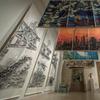Briefing Notes to the Art Industry’s Corner Offices
- June 25, 2020 12:51
The current environment feels as if we are bursting at the seams with anticipation and literally going through a period of ”pull and drag” to find out what is on the other side of the ongoing social unrest, health crisis and business openings.
For those who love, appreciate and work in the art world, we watch helplessly as the industry was decimated with closures, cancellations and postponements. Now governing bodies are proposing deep financial cuts to the arts along with layoffs. The current racially-charged social unrest gives us all pause and begs important questions on race, diversity and what and how can industries do better - beyond apology tours and knee jerk reactions.
Today, the art ecosystem suddenly finds itself on what seems to be a hamster-wheel-march in search of answers to restart in a way where it will remain relevant and afloat.
When the dust settles what will the art and culture sectors find? Never before has getting the right messaging to centers of influence more important. Here is a chance to assess where you are today and plot a path to a new normal that will serve in the post-COVID and post social unrest environments.
While art speaks for itself, that voice could use some help at this time. This period presents opportunities alongside what seems insurmountable challenges to innovate, pivot and realign messaging as necessary, to stay current AND to serve up authentic answers to employees, clients and partners, and the public through the media.
In the short term, the ones who keep the industry afloat - collectors - are seeking information on what the new mix of brick and mortar openings - and online sales and exhibitions will now look like. I believe never before is the roles of curators, art historians and museum educators more important. Case and point Sotheby’s highly engaging short video series of curators’, directors’ and expert voices which serve as excellent examples of short, educational and delightful learning experiences about the art they sell.
Questions abound in an industry which seems decimated and trying to find its new survival sea legs, which is certainly not known for its practice in diversity:
It is time for the art industry to ponder and develop answers to their biases. Research by company Wondeur.ai is well placed to chart and execute bias indexes. The informed solutions then become functions of leadership along with their boards, tech and marketing/communication departments.
- What concrete steps must the art industry take to invite a more diverse work environment? Will it result from teaching about art from a truly historic perspective, or inviting deep participation from a broader talent pool?
- Additionally, now seems like a good time to ponder and map solutions to what changes galleries, museums and art projects can implement to make clients’ journeys more engaging and enjoyable?
- Is a continual monthly scheduled ZOOM conversation an opportunity to stay engaged and connected with audiences even after the pandemic?
- Which arts organizations represent best practices in online viewing and virtual sales of art works?
- What will visits to the open doors of brick and mortar galleries and museums and art projects look like?
- With the majority of mid-career and emerging artists’ basically facing career decimations, they are continuing to seek information on rapidly-available financial resources, upcoming commissions, open gallery opportunities and art prizes?
- How can you be helpful in contributing to the development of careers of under-represented artists? Can a program of awarding signed monthly prints serve to make frontline workers‘ lives more pleasant while bringing attention to emerging artists?
- For those concerned with value, has the corona virus pandemic impacted the value of art? Has the value of art changed over the period?
- With a significant portion of art sales / art buying transitioned online, what questions should I be concerned with in terms of packaging, transporting and insuring art?
- What is the industry doing to make their employees true ambassadors of the arts?
- Is the art industry doing enough to attract the next generation?
- How has partnership relationships evolved over this period? Are they still serving their original purpose or is there a need to redefine the purpose?
Leadership’s answers and solutions to some of the above questions may prove eye-opening and revolutionary.
Note to the “Corner Office”, keep your audience informed about your direction going forward. Be creative in the way you communicate. Watch out for information overload which then becomes a turn off. Since we find ourselves in the age of mixing the new and old, it may be the right time to dust off communicating to a broader audience both by the good old press release, a newsletter along with social media and video messaging.
Communicating the right messages to clients, employees and partners post-pandemic and in the ongoing social uprising, has clandestinely become our new normal. Helping to drive direction, carefully managing relationships and getting the right messages to the marketplace takes experience, skill, tact, humility and a healthy dose of listening.
This Blog Post first appeared in LinkedIn by Roz Welsh Joseph a communication and relationship management specialist with more than 20 years experience supporting CEOs, Senior Level marketing and country managers on global communications, public relations and relationship management. In addition to continuing her international communication activities through Roz Joseph Group, she passionately promotes the work of emerging and mid-career artists through public relations and through the boutique art storefront RJG Select Art. For assistance you may contact Roz at: Roz@rozjosephgroup.com Web: rozjosephGroup.com











100x100_c.jpg)

![Peter Paul Rubens (Flemish, 1577–1640), After Titian (Tiziano Vecelli) (Italian [Venetian], c. 1488–1576), Rape of Europa, 1628–29. Oil on canvas, 71 7/8 x 79 3/8 in. Peter Paul Rubens (Flemish, 1577–1640), After Titian (Tiziano Vecelli) (Italian [Venetian], c. 1488–1576), Rape of Europa, 1628–29. Oil on canvas, 71 7/8 x 79 3/8 in.](/images/c/e2/2e/Jan20_Rape_of_Europa100x100_c.jpg)







